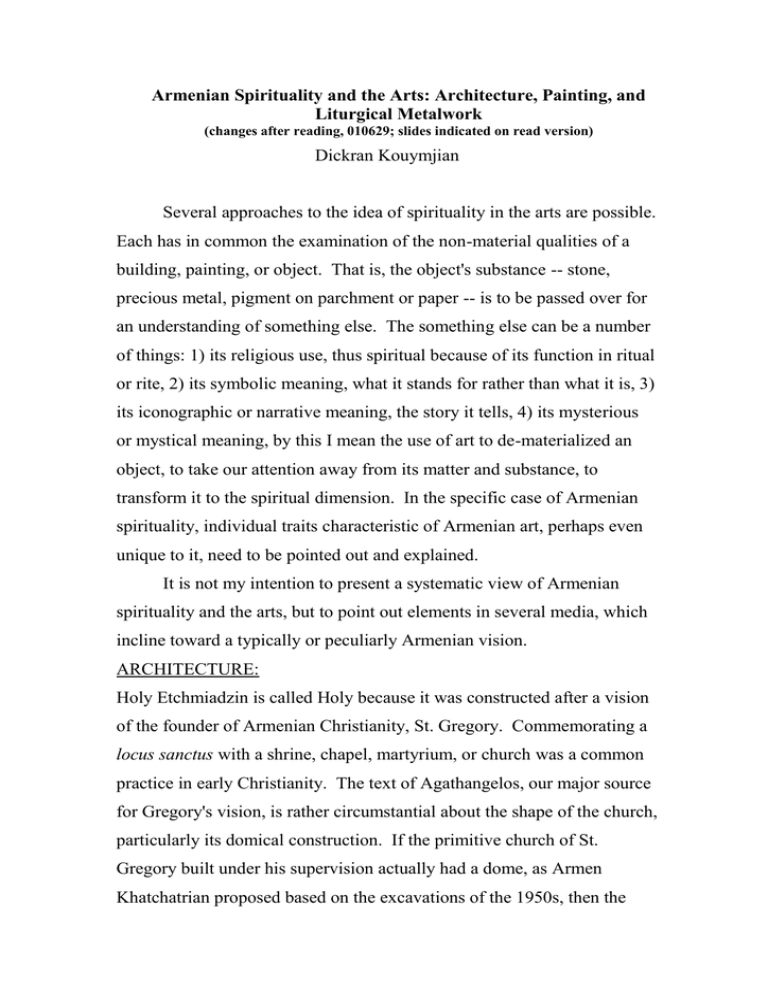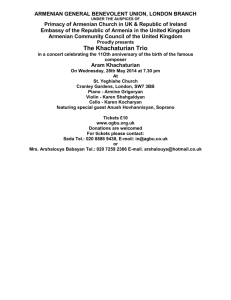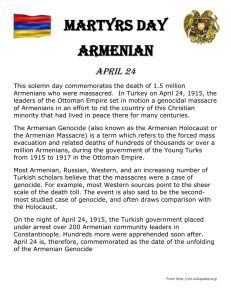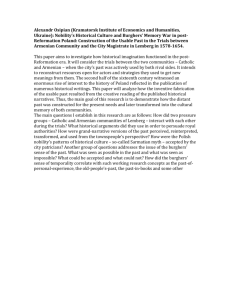Armenian Spirituality and the Arts: Architecture, Painting, and Liturgical Metalwork Dickran Kouymjian
advertisement

Armenian Spirituality and the Arts: Architecture, Painting, and Liturgical Metalwork (changes after reading, 010629; slides indicated on read version) Dickran Kouymjian Several approaches to the idea of spirituality in the arts are possible. Each has in common the examination of the non-material qualities of a building, painting, or object. That is, the object's substance -- stone, precious metal, pigment on parchment or paper -- is to be passed over for an understanding of something else. The something else can be a number of things: 1) its religious use, thus spiritual because of its function in ritual or rite, 2) its symbolic meaning, what it stands for rather than what it is, 3) its iconographic or narrative meaning, the story it tells, 4) its mysterious or mystical meaning, by this I mean the use of art to de-materialized an object, to take our attention away from its matter and substance, to transform it to the spiritual dimension. In the specific case of Armenian spirituality, individual traits characteristic of Armenian art, perhaps even unique to it, need to be pointed out and explained. It is not my intention to present a systematic view of Armenian spirituality and the arts, but to point out elements in several media, which incline toward a typically or peculiarly Armenian vision. ARCHITECTURE: Holy Etchmiadzin is called Holy because it was constructed after a vision of the founder of Armenian Christianity, St. Gregory. Commemorating a locus sanctus with a shrine, chapel, martyrium, or church was a common practice in early Christianity. The text of Agathangelos, our major source for Gregory's vision, is rather circumstantial about the shape of the church, particularly its domical construction. If the primitive church of St. Gregory built under his supervision actually had a dome, as Armen Khatchatrian proposed based on the excavations of the 1950s, then the D. Kouymjian, Armenian Spirituality and the Arts, Bossey June 2001 2 Armenian inclination for churches with domes began with the establishment of Christianity. From the late fourth to the sixth centuries, experiments were made with domeless, longitudinal basilicas imported from Byzantine Syria, churches such as Ererouk and Tsitsernavank. But this mode was short lived and abandoned for churches with domes. The dome as the vault of heaven has a long history, but in church building in the paleo-Christian period a good case can be made for Armenia as both the earliest and most consistent user of the form. It is precisely this element which compelled the faithful to look upward to heaven, the realm of the spiritual. In the medieval period when architects searched to accentuate the height of domes, the purpose was purely spiritual, as in the somewhat later gothic movement toward height. The additional space was empty, non-functional, purely spiritual in inspiration. Though Armenians seldom used the dome for a more explicit message (as did the Greeks with the custom of using the bust of Christ Pantocrator), at times a very subtle non-iconic representation as the 12 rays representing the apostles and perhaps even Pentecost in the dome of St. Hripsime of 618. The 11th century western dome of St. Mark's in Venice with its luxurious Pentecost mosaic shows its full embodiment. The external decoration of certain churches, Aght'amar being the most remarkable, also served to make of a stone wall a vehicle for the Biblical narrative. On a totally different level is the use of stone crosses, the famous Armenian khatchkars on the facades of churches. This is a quite different phenomenon, I believe, than the simple use of khatchkars, which I will discuss shortly. On such churches as Garmravor, Hovhannavank, and Noravank, the multiplicity of memorial crosses placed side by side on nearly every portion of the surface comes close to an act of dematerialization of the stone walls, turning them into a massive spiritual screens of ex votos. At Geghart, an entire cliff has thus been transformed. D. Kouymjian, Armenian Spirituality and the Arts, Bossey June 2001 3 This very same notion of converting an object into a recipient of prayerful offerings is seen on innumerable gospels books, usually surviving as the most sacred object of a village church, such as this 15th century example from the Matenadaran and the cover of the Vehamor Gospels of an even earlier date covered with ex votos. Much the same feeling is given by the silver covers of the famous Partsrpert Gospels in the Cilician Museum at Antelias, the oldest surviving dated Armenian manuscript binding, with its profusion of motifs (and ex voto). LEATHER BINDINGS Traditional Armenian leather manuscript bindings also developed a coded spiritual message, still enigmatic even to specialists. Starting from a period earlier than our oldest surviving examples, the upper cover of Gospels manuscripts were tooled with a braided cross mounted on a stepped pedestal: a clear vision of the cross on Golgotha, a symbol of the crucifixion. There are hundreds of examples: from nearly every collection including that of Antelias. The Crucifixion on the upper cover is clear and its meaning too, for it is the central message of the Gospels. But what about the lower cover, what is that braided rectangle? Can we assign a meaning to it? Thus far the literature has failed to do so, except my own oblique references hidden away in footnotes. A look at later bindings, especially those in silver, of which there is an abundance in Antelias, very often shows the Crucifixion on the upper cover and on the lower the Resurrection, here in a late 17th century binding in the Freer Gallery in Washington. Here are a few examples of lower covers from the Antelias collection, mostly of the 18th and 19th century. The pairing of Crucifixion (death) with Resurrection (new life) is the very essence of Christianity and it is no accident that the theme is used more consistently on later gospel bindings than showing Christ rising, or floating up, from the tomb, a western depiction of the theme, which became popular in late D. Kouymjian, Armenian Spirituality and the Arts, Bossey June 2001 4 medieval times. In the Byzantine tradition Resurrection was portrayed by Christ's descent into hell, the Anastasis, on the eve of Easter Sunday. Armenians borrowed both of these iconographies of the Resurrection, the Byzantine in the 13th century the Latin one in the 17th century. Early Armenian iconography was very faithful to the paleo-Christian representations of the Resurrection, namely showing the Holy Women at the empty tomb on Eastern Sunday. The earliest images of Resurrection, the pilgrim box in the Vatican and the ampullae from the Holy Land, all sixth century objects, show precisely this version of Resurrection. It is from one of these flasks that we see already before 600 the outer stone slab covering Christ's tomb drawn as a rectangle. The same shape, a rectangle is used to render Christ's tomb in the Armenian examples and in the famous miniature of 586 from the Syriac Rabbula Gospels bringing together the Crucifixion and the Resurrection. The same rectangular stone is depicted in the parallel to Christ's Resurrection, the Raising of Lazarus, as scene here in a miniature of Toros Roslin from the 1260s now in the Freer Gallery. Thus, in Armenian Gospel manuscript bindings, the rectangle most certainly represents the empty tomb or at least the stone removed from it, that is the expected Resurrection. Its understanding transforms two plaques of leather into powerful shorthand for the central meaning of the Gospel message. KHATCHKARS Khatchkars are regarded as a unique Armenian art form, and indeed, except for a limited number of early Irish stone crosses, no other Christian tradition employed their use. Cemeteries of these crosses are still to be seen in Armenian, Noraduz, and until recently at Julfa on the Arax. There are thousands of them scattered over the Armenian countryside and affixed to churches. They were both commemorative monuments and tombstones. The importance of the cross in Armenian art D. Kouymjian, Armenian Spirituality and the Arts, Bossey June 2001 5 as the central message of Christianity has already been amply shown. From the very beginning the cross stones showed a single dominating motif, a naked cross, not the Crucifixion (except for a few 13th century exceptions). But from the earliest surviving khatchkars of the late ninth and tenth centuries, the cross has leaves growing out of its base, usually as stylized palmettes. The oldest cross in stone in Armenian art is represented on the altar of the mausoleum of Aghdz dated to 361. Throughout the thousand years of khatchkar production, the cross was always shown with foliage. In this way Armenian artists made clear that the cross of the Crucifixion is a living cross, not made of dead wood, but of the living tree of life. Other pre-khatchkar examples in stone confirm this notion. The famous capital excavated at Dvin is a striking example and another cross, probably of the early seventh century, is perhaps the most eloquent testimony of the spiritual nature of these works of art. Through the living cross of the khatchkars, we have more than just a symbol here; it is in itself a dogmatic or doctrinal statement, one that relies entirely on the spiritual. PAINTING Since Dr. Dadoyan will treat painting, I shall limit my remarks to a single miniature, which shows clearly the spiritual implications behind all gospel illuminations. It is the scene of Baptism, probably the oldest surviving representation of this event in Armenian art, part of the earliest illustrated Armenian manuscript, the final four miniatures of the Etchmiadzin Gospels now in the Matenadaran. This short cycle, the surviving fragment of a Gospel, is painted on two parchment folios, bound in (probably in the eleventh century) at the very end of the Etchmiadzin Gospels, itself dated to 989. No text accompanies these pictures, no inscriptions are found on them, thus their date is assigned by an D. Kouymjian, Armenian Spirituality and the Arts, Bossey June 2001 6 iconographical and stylistic analysis and the artist remains anonymous. The attribution of these miniatures to the paleo-Christian period, circa 600, and to an Armenian artist by Siraprie Der Nersessian in the 1960s has had no serious challenges. As a group they stand isolated form the bulk of surviving Armenian manuscript illuminations, 250 years before the next oldest Armenian miniatures of the ninth century. The cycle includes the Annunciation to the high priest Zechariah, the Annunciation to the Virgin, and you note the position of the archangel and the protagonists is the same only the architecture different in its positioning. The third miniature, the Presentation of the Magi, a substitute for the Nativity, unites the halfs of the early building. None of these miniatures are framed, suggesting perhaps that their model was monumental rather than miniature art. The final miniature, the Baptism, as you notice has a frame, one that we will discuss shortly. The miniature is of particular interest to our discussion of spirituality in the arts. From the start of scholarly attention to those miniatures, the question was posed whether these were the beginning of a longer cycle of miniatures, and if so, what other scenes would the series have included. Ms. Der Nersessian showed, I think conclusively, that indeed the Baptism was the final scene in a narrative cycle of the Life of Christ, which she considered exegetical or dogmatic rather than simply narrative. The illustrative arrangement of almost all early Armenian Gospels up through 1100 is as follows: the Letter of Eusebius to Bishop Carpianus, the ten canon tables, symbolic and narrative miniatures and finally portraits of the four Evangelists, all grouped together in the initial quire or gathering before the text of St. Mathew. In the corners of the miniature of Baptism are four portrait heads, undoubtedly the four evangelists, a must unusual arrangement, but a conclusive statement that the miniature cycle has ended with the Baptism. How strange, in fact almost unique, to D. Kouymjian, Armenian Spirituality and the Arts, Bossey June 2001 7 have a cycle confined to Annunciation, Nativity and Baptism: the Incarnation without Crucifixion and Resurrection. We saw in the near contemporary Rabbula Gospels the idea of salvation united with the latter scenes. It is here that the frame of this miniature helps us understand better the unity of these four paintings. It is extremely difficult to perceive clearly the elements that make up the border because of the state of the miniature even though my slide is taken directly from the manuscript. I think you can make out a chalice resting on a paten, both in gold, on the rim of the chalice is a rounded pink shape, which is the body of a bird, the wings above. This repeated figure is in the act of using its beak to tear apart its breast. Those familiar with the first century Greek text known as the Physiologus, know that the Pelican is the bird in question, one which, when its babies have no other source of food, tears open her breast and feeds her children with her own flesh and blood. Thus, the artist has made clear that the redemption is depicted in this miniature of sacrifice. Indeed the position of the pelican is such that's its blood drips into the chalice, much as in later times we see especially in Latin miniature of the Crucifixion an angel holding a chalice under Christ's wound to catch His blood. The spiritual content is very powerful, one of the most striking in all of Armenian iconography. It also clearly reflects the importance of the Baptism to the Armenian Church, a feast celebrated on the same day as the Nativity. The act of Baptism, and as you see by the youthful Christ Emmanuel in the miniature it is a moment after child baptism became popular, was sufficient in itself for ultimate Christian grace and salvation. Robert Thomson in his publication of the fifth century catechism, The Teachings of St. Gregory, an interpolation into the text of Agathangelos, has underlined the importance of Baptism to the early Armenian Church. LITRUGICAL OBJECTS D. Kouymjian, Armenian Spirituality and the Arts, Bossey June 2001 8 Among the most striking of liturgical implements is the flabellum, the rhipidion, in Armenian kshots', the liturgical fan, almost always used in pairs and manipulated by the deacons at certain moments of the liturgy in a rhythmic manner. Its music is due to little bells or metal balls (usually twelve in honor of the Apostles who took the first communion) attached to the circumference of the disk, which bang against the disk when the staff holding the flabellum is twisted from the wrist by the deacon. It was used from earliest Christian times to keep flies and insects away from the Eucharistic chalice. Our oldest surviving examples are Byzantine from the mid-sixth century, in silver, from hoards of liturgical vessels excavated in Syria. The decoration of the flabellae was always singular: the field was dominated by a seraph. The seraphim were the highest of the hierarchy of angels; massive in size, they stood guard over the tabernacle. The Armenian kshots invariably preserves this usage of the seraphim, even though the oldest examples preserved date only to the eighteenth and nineteenth centuries, I suppose mostly because of all liturgical implements, they are the ones that get the most use or abuse. Here is a pair of flabella from the Cilician Museum dated to the first quarter of the nineteenth century, with, as you see, a very stylized and quite striking rendering. Another from Erevan of a later date, but also nineteenth century repeats the seraphim design. It is the spiritual nature of the central motif that is of interest, the seraph as protector, as guardian, perfectly appropriate for its primitive use associated with the Eucharist. It can be fond very often on chalices themselves, as this nineteenth century examples from the Cilician museum shows. Perhaps the most interesting and unique use of seraphim in Armenian art is their appearance on ceramic egg-shaped ornaments made in the Armenian pottery center of Kütahya in western Asia Minor. These eggs, now prize acquisitions of Ottoman ceramic collectors, were and still are principally used in D. Kouymjian, Armenian Spirituality and the Arts, Bossey June 2001 9 association with hanging lamps in churches. The largest surviving groups still in use are in the Armenian Patriarchate of St. James in Jerusalem. It is said that originally their function was to protect the oil in these lamps, which were in the pre-electrical age the main source of artificial light, from being eaten by mice. In the Middle East lamp oil was usually made of animal fat and mice were attracted to it. As the mouse made its way down the chain, which supported the lamp, it came to the egg (with its guardian seraphim) and simply lost footing and fell to the ground. Their presence, sometimes dozens of them, served as symbolic protectors with their vigilant seraphim hovering over the entire church. Curiously, or perhaps naturally, the seraph almost never appears on certain objects, for instance altar or hand crosses or on covers of the Gospels. A most interesting use of it is at the very end of the hand relic of St. Gregory the Illuminator, the famous ach, not in the Cilician Museum, but in a safe in the Catholicosate. The right hand relic was remounted in 1928 in Aleppo and the seraph may date from that period. Apparently, the goldsmith or Catholicos Sahag wanted to insure its safety, unfortunately, that did not prevent it from being stolen once again in 1956. RELICS Are relics signs of spirituality? The Armenian Church has a particular fondness for two sorts of relics: fragments of the true cross and dexters, or right arm relics, acher. We have already seen the importance of the cross in Armenian art, thus it is natural that there should be a fondness for pieces of the true cross. Of course, this particular type of relic is popular in all traditional churches. Important clergy wanted their hand cross, the one they used regularly in officiating, to have a fragment, usually a sliver, of the true cross. In the Cilician Museum there is a spear shaped altar relic with a fragment of the cross in it. It is perhaps spear shaped because the spear, which pierced Christ's side, is one of the most D. Kouymjian, Armenian Spirituality and the Arts, Bossey June 2001 10 famous of Armenian church relics, kept originally at the monastery of the spear, Geghart. But in fact that relic is the metal tip of the spear, dark iron color, therefore, making suspect any argument that the reliquary was originally intended for a piece of the spear. As you see in this detail of the relic, a pious priest made sure that everyone would understand the meaning of the cross and wrote next to it, "the living cross, genats payd," affirming the tradition of the cross of the khatchkar tradition. As you can see there was once a seraph there. I have not been able to determine just why Armenians chose as their favorite relic the dexter. Right arms of saints are preserved as relics in Ireland and various parts of Europe, the usage dating back to the eleventh century. In my small inventory I have already listed no fewer that 22 Armenian examples including among them: three of St. Gregory (Antelias, Etchmiadzin, Jerusalem), Aristakes, the son of St. Gregory, Ghewond the priest of Vardanants fame, St. Stepannos, the Protomartyr, St. Thaddeus, two of John the Baptist, St James the brother of our Lord, two of St. Nicholas, St. Sylvester, St. Barsauma, St. James of Nisibis, and others. The aggressive preservation of the bones of saints was already a fifth century phenomenon. They were collected and buried under altars, but encasing the right hand in precious metal, and liturgical vessels were always of noble metals, usually silver chased with gold, as a practice in Armenia has not yet been historically studied. Already Eghishe goes into great detail about the collection of the bones of Armenians martyred in Persia. However, our oldest surviving encased right hand is the one of St Nicholas in the Cilician Museum, with an inscription of restoration of 1315 from Cilicia. This dates the reliquary and not the relic inside of course. Reliquaries deteriorated and were restored or renewed regularly, such is the case of both that of St. Sylvester and especially that of St. D. Kouymjian, Armenian Spirituality and the Arts, Bossey June 2001 11 Gregory in Antelias, which has a precisely dated inscription of the jeweler in Aleppo who fashioned the new casing, quite different from its look when it reach Aleppo after being rescued from Sis during the Genocide. The hand of St. Gregory has become itself a liturgical vessel, an indispensable part of the ritual of the church, used for the consecration of the Chrism. and brought out at the consecration of the Catholicos. Possession of the right hand of the Illuminator was also a sign of Patriarchal authority, perhaps explaining why each Catholicosate claims to three of the four Patriarchal sees possess the dexter-relic of St. Gregory. [This importance was clearly underlined when the famous mother ritual book of the Cilician Catholicosate was rebound with a silver casing in Adana in 1765, the artisan depicted on the upper cover the consecration of a bishop and on the other the consecration of the holy oil, the muron showing each of the right arms of St. Gregory, St. Nicholas, and St. Sylvester held by a bishop. (Unfortunately in my haste I forgot to include that slide, but the chest fashioned in the same year to house the three dexters just mentioned shows that of St. Gregory's dexter held during a consecration of the Chrism.). ] I have already discussed the spiritual importance of the dexter of the Illuminator by the seraph engraved at its end. In a sense the right hand of St. Gregory is more than a relic, when it is held up over the chrism cauldron by the Catholicos, it is in fact a symbol of the Armenian Church, its entire history and spiritual essence. Thus, in these various ways art or the arts associated with the church are heavy bearers of Armenian spirituality; perhaps through the arts we can begin teaching spirituality to a new generation alienated from the text and reading.



